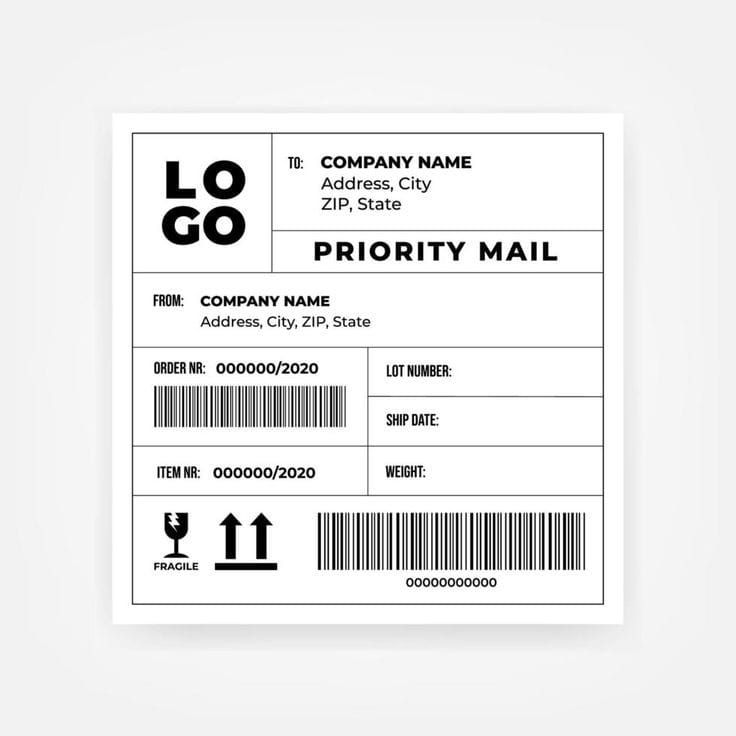Certain vital information about the items in a shipment is noteworthy for successful shipping and delivery of cargo. This information provides instructions on where a package is coming from, where it is going, how a package is to be handled, the nature of the package, the size and weight of the boxes, the company handling the package, and the delivery address. These details are enclosed in a document called a shipping label.
The labels make identifying the item easier for everyone involved in the shipping process. Though shipping labels may seem insignificant in the supply chain, they are critical to both inbound and outbound logistics and vital for a shipping process's overall success.
With clear shipping labels, orders could be recovered and handled correctly, creating a good customer service experience, protecting brand image, and ultimately delivering more sales.
Packages can also display a variety of information and instructions on shipping labels to direct them to their correct destinations, enable customers to track them throughout each stage and ensure that the proper service is provided.
Labels are designed to be read and understood by humans and machines, so they must be straightforward and easy to read. However, as with various industries and specific esoteric words that are familiar only within, shipping labels could be challenging to understand for the general populace because they contain a multitude of information in text, numbers, symbols, and codes that aren't easily comprehensible. We provide some clarity on this below.
The Contents Of A Shipping Label
1. Name and address of the sender:
The sender's name and address on the label will let the recipient know the origin of the package. It also serves as a marketing opportunity for the sender, bringing about brand visibility if it is a business.
In situations where there is the need to return the item, having the sender's address on the label will help to know where the parcel should be replaced.
2. Recipient name, address, and phone number:
This informs the carrier where to deliver the item and offers a communication link between the recipient and the carrier. This information must be accurate to deliver the package to the correct location.
3. Tracking barcode:
The unique tracking barcode on a package's shipping label helps to track the shipment's progress. They are scanned when the parcel enters or leaves a carrier facility.
4. Tracking number:
This is usually given to the customer. With this, they can track their packages anytime on the carrier of choice's platform.
5. Unidirectional or QR code:
The unidirectional code, MaxiCode, or QR code is a sign read by a machine. These codes have a digital form of the data on the shipping label.
6. Weight:
With the gross, net, and tare weight class importance of the package on the label, shipping rates will be easily calculated appropriately.
Additionally, the item's weight clearly outlined on the label ensures that packages are loaded onto vans efficiently with weight restrictions considered.
7. Shipping class:
This could be express or standard. The shipping class is also included on the labels to inform how the package should be handled and helps carriers determine if the box needs special handling or requires fast-track shipping.
The Importance Of Shipping Labels
Below are some reasons why shipping labels are crucial in the supply chain industry.
1. Tracking of shipments:
The shipping label allows customers to track packages from anywhere in the world. This allows customers to always know the location of their goods from the start to the end of the shipping process.
2. Identification of shipments:
Shipping labels contain information that can be used to identify the packages and their destination, like the name and the address of the recipient. They serve as unique identifiers for packages.
3. Reduction of error:
When packages are correctly labeled, it leaves little or no room for error in the box's identification, handling, and delivery. Accurate labeling ensures packages are delivered to the correct destination, minimizing costly mistakes and delays.
4. Reduction of the margin of damages:
Shipping labels usually contain the package's content and leave instructions for those handling the product. This way, the handlers will know when a shipment is fragile and how to load it.
5. Efficient and timely sorting:
A shipping label enables the package to be sorted using machines and an automated sorting system. This way, parcels are cleared quickly based on the sorting system.
6. Efficient transportation and customer satisfaction:
The shipping label helps the parcel reach the final customer efficiently. It also reduces costs for companies and improves efficiency and customer satisfaction.
7. Efficient delivery time:
When all the necessary data is available on the shipping label, the courier's job is also reduced.
Types Of Shipping Labels
Depending on the package being shipped, there are different types of shipping labels, each conveying a unique message.
1. Arrow labels:
This type of label directs whoever will handle the package on the side of the package to face upward based on the direction of the arrow printed on the box. It's often used for electric, electronics, or industrial products.
2. Fragile labels:
This label indicates that a package's contents should be handled with care. Also, such labels must be bold and easily visible, often printed in bright colors.
3. Dot labels:
Such labels indicate if the contents of a package are flammable, corrosive, explosive, poisonous, etc. They are significant, and the absence of such could pose dangerous risks. Hence, these labels are often printed in bright colors with bold text.
4. Address Labels:
This is the most basic shipping label required for all packages. The sender or the carrier can generate these labels. It includes the addresses of both the recipient and sender, the shipping class, the weight, the bar code, and other information. If a package doesn't have this label, it won't reach its destination.
5. International Shipping Labels:
International shipping labels are necessary for international shipping. Each country has its requirements and regulations about shipping, which are considered while designing an international shipping label. These labels tend to contain more information than a domestic address label.
At SARA PROCURE and our ChinatoLagos brands, all items are correctly packed with the appropriate shipping labels from the origin to the destination. We prioritize your shipment to ensure a seamless and smooth freight process.
To get more information, visit our physical office space at 3 Fatai Irawo Street, Ajao Estate, Airport Road, Lagos, Nigeria, or any of our warehouse touchpoint locations worldwide.
Our 24/7 email correspondence is hello@chinatolagos.com. Contact us today.
We are equally social, and you can find us @SaraProcure and @ChinatoLagos on your favorite channels, Twitter, Threads, Facebook, and Instagram.






Comments
Please log in to leave a comment.